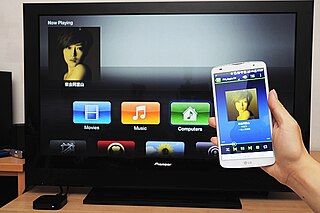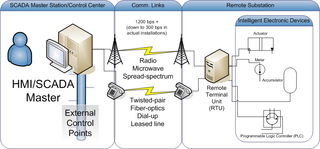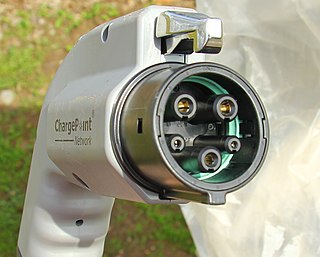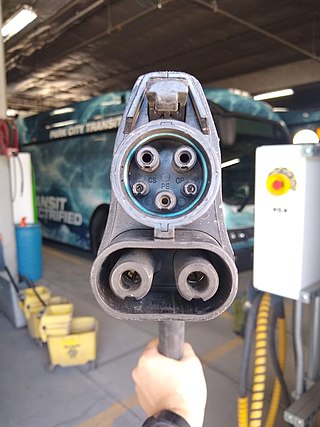Related Research Articles

Interoperability is a characteristic of a product or system to work with other products or systems. While the term was initially defined for information technology or systems engineering services to allow for information exchange, a broader definition takes into account social, political, and organizational factors that impact system-to-system performance.

Distributed Network Protocol 3 (DNP3) is a set of communications protocols used between components in process automation systems. Its main use is in utilities such as electric and water companies. Usage in other industries is not common. It was developed for communications between various types of data acquisition and control equipment. It plays a crucial role in SCADA systems, where it is used by SCADA Master Stations, Remote Terminal Units (RTUs), and Intelligent Electronic Devices (IEDs). It is primarily used for communications between a master station and RTUs or IEDs. ICCP, the Inter-Control Center Communications Protocol, is used for inter-master station communications. Competing standards include the older Modbus protocol and the newer IEC 61850 protocol.

Network Security Services (NSS) is a collection of cryptographic computer libraries designed to support cross-platform development of security-enabled client and server applications with optional support for hardware TLS/SSL acceleration on the server side and hardware smart cards on the client side. NSS provides a complete open-source implementation of cryptographic libraries supporting Transport Layer Security (TLS) / Secure Sockets Layer (SSL) and S/MIME. NSS releases prior to version 3.14 are tri-licensed under the Mozilla Public License 1.1, the GNU General Public License, and the GNU Lesser General Public License. Since release 3.14, NSS releases are licensed under GPL-compatible Mozilla Public License 2.0.
IEC 60870 part 6 in electrical engineering and power system automation, is one of the IEC 60870 set of standards which define systems used for telecontrol in electrical engineering and power system automation applications. The IEC Technical Committee 57 have developed part 6 to provide a communication profile for sending basic telecontrol messages between two systems which is compatible with ISO standards and ITU-T recommendations.

SAE J1772, also known as a J plug or Type 1 connector after its international standard, IEC 62196 Type 1, is a North American standard for electrical connectors for electric vehicles maintained by SAE International under the formal title "SAE Surface Vehicle Recommended Practice J1772, SAE Electric Vehicle Conductive Charge Coupler".
The CC-Link Open Automation Networks Family are a group of open industrial networks that enable devices from numerous manufacturers to communicate. They are used in a wide variety of industrial automation applications at the machine, cell and line levels.
iSCSI conformance testing is testing to determine whether an iSCSI Initiator/Target meets the iSCSI standard.

IEC 62196Plugs, socket-outlets, vehicle connectors and vehicle inlets – Conductive charging of electric vehicles is a series of international standards that define requirements and tests for plugs, socket-outlets, vehicle connectors and vehicle inlets for conductive charging of electric vehicles and is maintained by the technical subcommittee SC 23H “Plugs, Socket-outlets and Couplers for industrial and similar applications, and for Electric Vehicles” of the International Electrotechnical Commission (IEC).
CIPURSE is an open security standard for transit fare collection systems. It makes use of smart card technologies and additional security measures.
Avnu Alliance is a consortium of member companies working together to create an interoperable ecosystem of low-latency, time-synchronized, highly reliable networking devices using the IEEE open standard, Time-Sensitive Networking (TSN) and its Pro AV networking protocol, Milan. Avnu Alliance creates comprehensive certification programs to ensure interoperability of network devices. In the Professional Audio Video (AV) industry, Alliance member companies worked together to develop Milan: a standards-based, user-driven deterministic network protocol for professional media, that through certification, assures devices will work together at new levels of convenience, reliability, and functionality. Milan™ is a standards-based deterministic network protocol for real time media. Avnu Members may use the Avnu-certified or Milan-certified logo on devices that pass the conformance tests from Avnu. Not every device based on AVB or TSN is submitted for certification to the Avnu Alliance. The lack of the Avnu logo does not necessarily imply a device is incompatible with other Avnu-certified devices. The Alliance, in conjunction with other complimentary standards bodies and alliances, provides a united network foundation for use in professional AV, automotive, industrial control and consumer segments.

The Combined Charging System (CCS) is a standard for charging electric vehicles. It can use Combo 1 (CCS1) or Combo 2 (CCS2) connectors to provide power at up to 350 kilowatts (kW) . These two connectors are extensions of the IEC 62196 Type 1 and Type 2 connectors, with two additional direct current (DC) contacts to allow high-power DC fast charging. In response to demand for faster charging, 400 kW CCS chargers have been deployed by charging networks and 700 kW CCS chargers have been demonstrated.
The electric vehicle industry in India is slowly growing. The central and state governments have implemented schemes and incentives to promote electric mobility, and have introduced regulations and standards.
IEC 63110 is an international standard defining a protocol for the management of electric vehicles charging and discharging infrastructures, which is currently under development. IEC 63110 is one of the International Electrotechnical Commission's group of standards for electric road vehicles and electric industrial trucks, and is the responsibility of Joint Working Group 11 (JWG11) of IEC Technical Committee 69 (TC69).

ISO 15118Road vehicles -- Vehicle to grid communication interface is a proposed international standard defining a vehicle to grid (V2G) communication interface for bi-directional charging/discharging of electric vehicles. The standard provides multiple use cases like secure communication, smart charging and the Plug & Charge feature used by some electric vehicle networks.

IEC 61851 is an international standard for electric vehicle conductive charging systems, parts of which are currently still under development(written 2017). IEC 61851 is one of the International Electrotechnical Commission's group of standards for electric road vehicles and electric industrial trucks and is the responsibility of IEC Technical Committee 69 (TC69).

SAE J3068 "Electric Vehicle Power Transfer System Using a Three-Phase Capable Coupler" is a North American recommended practice published and maintained by SAE International. J3068 defines electrical connectors and a control protocol for electric vehicles. It has the formal title "SAE Surface Vehicle Recommended Practice J3068". J3068 defines a system of conductive power transfer to an electric vehicle using a coupler capable of transferring single-phase and three-phase AC power as well as DC power, and defines a digital communication system for control. J3068 also specifies requirements for the vehicle inlet, supply equipment connector, mating housings and contacts.
The GB/T charging standard is a set of GB/T standards, primarily in the GB/T 20234 family, for electric vehicle AC and DC fast charging used in China. The standards were revised and updated most recently in 2015 by the Standardization Administration of China. The term is an abbreviation of 国标推荐 (guóbiāo/tuījiàn), translated as "recommended/voluntary national standard".
EEBUS is a protocol suite for the Internet of things that aims to standardize the interface between electrical consumers, producers, storages, and (logical) managing entities. It builds on Internet Protocol and related standards and is meant to be highly generic, cross-domain applicable, open, and free to the public. While its main area of application is the Energy demand management, data exchange, and control of appliances it is also specified for Home automation. A business logic is not specified by EEBUS. The EEBus Initiative e.V. is the non-profit association that manages and supports the standardization of EEBUS.

The Megawatt Charging System (MCS) is a charging connector under development for large battery electric vehicles. The connector will be rated for charging at a maximum rate of 3.75 megawatts.

The IEC 62196 Type 3 connector is used for charging battery electric vehicles, mainly within France and Italy, as it was one of three AC plug standards described in IEC 62196-2. The Type 3 connector comes in two physical formats, Type 3A for single-phase (230V) and Type 3C for single- and three-phase (400V) alternating current (AC) power. Both have since been superseded by the Type 2 connector, the latter adopted as sole connector in 2013 by the European Union. The Type 1 connector is the corresponding AC connector standard used in North America, Japan, and South Korea.
References
- ↑ "Welcome to t Charge Alliance". Ocppforum.net. Retrieved 2013-10-12.
- ↑ "ElaadNL". ElaadNL. Retrieved 2019-05-23.
- ↑ "Open Charge Alliance Participants".
- 1 2 "Open Charge Point Protocol OCPP". Infrastructure.switchev.co.uk. Archived from the original on 2012-06-21. Retrieved 2013-10-12.
- ↑ "Open Charge Point Protocol (OCPP) Security Explained". WEVO. 2022-10-17. Retrieved 2022-10-17.
- ↑ "Certified companies - Open Charge Alliance". www.openchargealliance.org. Retrieved 2022-10-17.
- ↑ "National Electric Vehicle Infrastructure Standards and Requirements". transportation.gov. 2023-02-23. Retrieved 2023-11-11.
- ↑ "FACT SHEET: Biden-Harris Administration Announces New Standards and Major Progress for a Made-in-America National Network of Electric Vehicle Chargers". whitehouse.gov. 2023-02-15. Retrieved 2023-11-11.
- ↑ "Energy Department Partners with EU on Electric Vehicle and Smart Grid Coordination | Department of Energy". Energy.gov. 2013-07-19. Retrieved 2013-10-12.